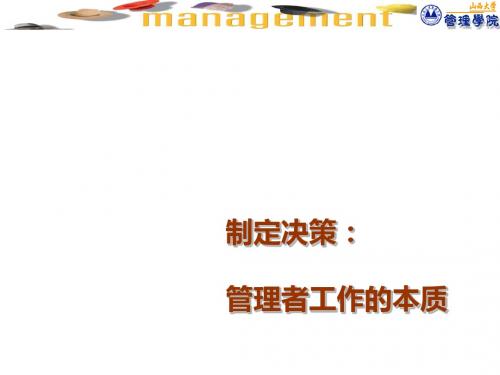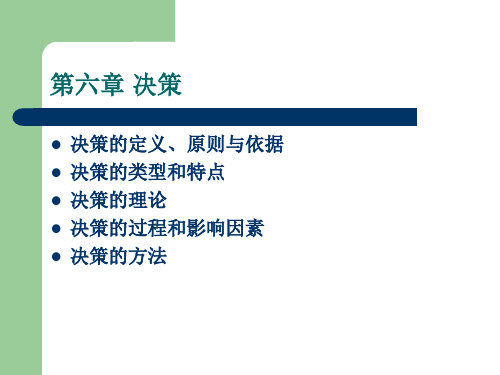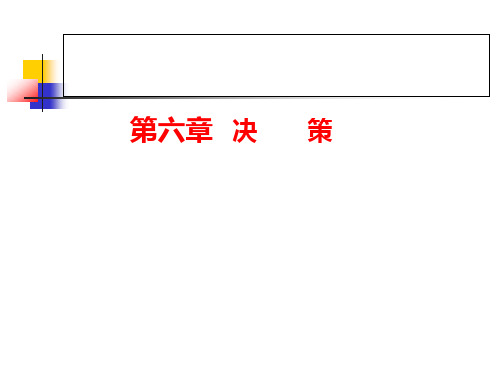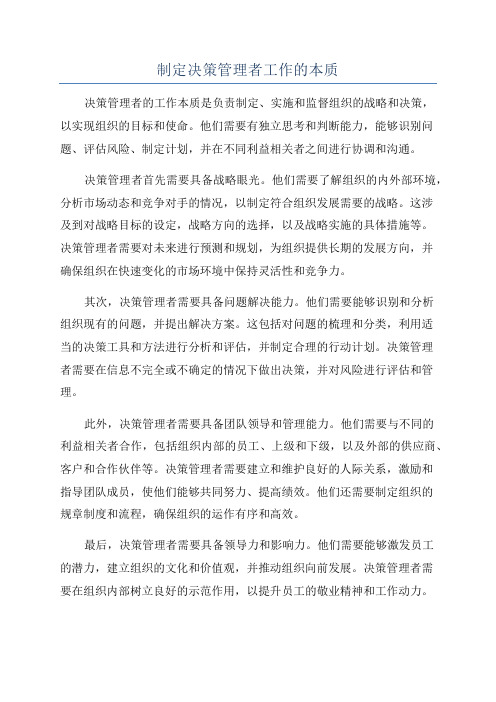管理学课件第6章制定决策管理者工作的本质(Decision--PPT精品文档
《管理学基础》第六章制定决策管理者工作的本质

Ø 具有唯一性和不可重复性的解决方案 Ø 根据问题制定解决的方案
PPT文档演模板
《管理学基础》第六章制定决策管理 者工作的本质
图表 6–8 程序化决策与非程序化决策
PPT文档演模板
《管理学基础》第六章制定决策管理 者工作的本质
决策制定条件
• 确定性
Ø 在这种情况下,因为每一种方案的结果是已知的,管 理者可以指定出精确的决策
Ø 决策者有重点的选择事物的某些方面,而摒弃别的方 面
• 有效性偏见
Ø 过度强调最近发生的事情造成决策失去客观性
• 典型性偏见
Ø 进行类比,以相似度判断事件发生的可能性
• 随机性偏见
Ø 从随机事件中归纳出某种结论
PPT文档演模板
《管理学基础》第六章制定决策管理 者工作的本质
决策的偏差和错误(续)
• 沉没成本偏见
PPT文档演模板
《管理学基础》第六章制定决策管理 者工作的本质
学习纲要 (续)
请遵循该学习纲要阅读、学习本章节
作为决策者的管理者 (续)
• 比较决策制定的三个条件 • 解释最大最大、最大最小、最小最小三种决策选择标准 • 描述决策制定的四种风格 • 详述管理者可能表现出来的12种决策制定的偏见 • 描述管理者如何应对决策失误和偏见的负面影响 • 解释管理上的决策制定模型
决策制定
• 决策
Ø 在两个或多个方案中做出选择
• 决策制定过程
Ø 识别决策问题和确定决策标准,以及为每个决策标准 分配权重
Ø 开发、分析和选择解决问题的备选方案 Ø 实施备择方案 Ø 评价基础》第六章制定决策管理 者工作的本质
图表 6–1 决策制定过程
PPT文档演模板
第章制定决策:管理者工作的本质PPT课件

指导程序化决策的三种方式:
程序 - 相互关联的一系列顺序的步骤,用以对
结构化的问题做出响应。
规则 - 明确的陈述,告诉管理者能做什么和不
能做什么。
政策 – 制定决策的指南,管理者有一定的酌情
处理权。
2020/1/12
理性假设
定义:管理者制定决策是理性的,所制定决策前 后一致,追求特定条件下价值最大化。
传统的决策模式认为管理者在决策时,都是依据 理性和逻辑,且总是从组织的最佳利益出发的。
决策制定在实际中并不完全符合理性假设条件。
2020/1/12
可编辑
6
理性假设的前提条件
所有的方案和 结果是已知的
组织
控制
直接向我汇报的职员应当有多少? 组织应当有多大程度的集权? 职位应当怎么设计? 什么时候组织应当实行不同的结构?
需要对组织中的哪些活动进行控制? 怎么控制这些活动? 绩效差异偏离到什么程度是显著的? 组织应当具有什么类型的管理信息 系统?
2020/1/12
可编辑
5
决策制定方式:理性、有限理性和直觉
根据经验制定决策
基于经验的决策
基于价值观或 道德的决策
直觉
根据感觉或情绪 制定决策
情感引发 的决策
潜意识的 心理过程
基于认知的 决策
运用潜意识的信息 帮助其制定决策
2020/1/12
可编辑
根据技能、知识 和训练制定决策
13
二、作为决策者的管理者
问题和决策的类型
结构良好的问题 – 一目了然的、熟悉的、易定义的
Accord
Camry Teana
管理学课件第6章制定决策管理者工作的本质(Decision

v Will not seek out or have knowledge of all alternatives
v Will satisfice—choose the first alternative encountered that satisfactorily solves the problem—rather than maximize the outcome of their decision by considering all alternatives and choosing the best.
v Are perfectly rational, fully objective, and logical. v Have carefully defined the problem and identified all viable
alternatives. v Have a clear and specific goal v Will select the alternative that maximizes outcomes in the
• Choosing the best alternative
Ø The alternative with the highest total weight is chosen.
Step 7: Implementing the Alternative
• Putting the chosen alternative into action.
管理学课件第6章制定决策管理者工 作的本质(Decision
The Role of Intuition(直觉的作用)
制定决策管理者工作的本质讲义(PPT 65张)

管理学》课件 山西大学管理学院 范建平
6–15
决策制定过程
管理学》课件 山西大学管理学院 范建平
6–16
步骤 8:评价决策结果
• 通过方案产生的结果判断其合理性
选择方案的实施对问题解决的有效性如何? 如果问题没有解决,问题出在哪里?
管理学》课件 山西大学管理学院 范建平
6–17
二、作为决策者的管理者
长期决策:有关组织今后长期发展方向的长远性、 全局性的重大决策,例如:投资方向、人力资源开 发和组织规模的确定等等。 短期决策:为实现长期战略目标而采取的短期策 略手段。例如:日常营销、物资储备、生产中的资 源分配等。
管理学》课件 山西大学管理学院 范建平
6–25
2、根据决策重要性 ⑴ 战略决策:长期性的,方向性的。涉及组织的方方 面面。例如组织目标、方针的确定、组织机构的调整 等等。 ⑵ 战术决策:也称管理决策,是组织内贯彻的决策, 执行战略的具体决策。例如:生产计划、设备更新、 新产品定价等。 ⑶ 业务决策:也称执行决策,是日常工作中为提高生 产效率、工作效率而作出的决策。
管理学》课件 山西大学管理学院 范建平
管理学》课件 山西大学管理学院 范建平
6–19
图表 6–6 理性假设
管理学》课件 山西大学管理学院 范建平
6–20
• 有限理性
管理者理性的做出决策,但同时也受到自身信息处理 能力的限制 有限理性决策者隐含的假设:
没有搜索出并了解所有的备择方案 将满足于—能解决问题的第一种解决方案—而不是考虑所有的 方案,选择最优方案进而使产出最大化
6–32
5、根据决策信息
可分为:确定型决策、风险型决策、非确定型决策
管理学管理者工作的本质PPT课件

– 第7步 – 实施方案
• 实施 – 向受该决策影响的人传达决策并取得他们的支持
– 人们参与决策制定过程能促使他们支持相应的决策结果 – 如果实施不当将可能导致决策失败
– 第8步 – 评价决策效果
• 判断问题是否被解决
© Prentice Hall, 2002
6-8
© Prentice Hall, 2002
6-3
确定问题 “我的销售人员需要电脑”
分析备选方案
决策制给定标准过分配权程
确定决策标准
重
提出备选方案
价格 重量 担保 屏幕类型 可靠性 屏幕大小
选择方案
可靠性 10
屏幕大小 8
担保
5
重量
5
价格
4
屏幕类型 3
实施方案
Acer Compaq Gateway HP Micromedia NEC Sony Toshiba
明先前的决策很可能是错误的
• 拒绝承认先前的决策可能有缺陷
© Prentice Hall, 2002
6-12
• 直觉的作用
– 直觉决策 – 在经验和累积判断基础上的
下意识决策过程
• 不对问题进行系统和全面的分析 • 通吃是对理性决策的补充
© Prentice Hall, 2002
6-13
什么是直觉?
– 最小限度的运用管理者的自主判断能力 – 促进组织效率
• 程序 – 处理结构性问题的一系列相互联系的连续步骤 • 规则 – 清楚表明可以做什么不可以做什么的陈述 • 政策 – 决策制定的方针
© Prentice Hall, 2002
6-15
• 问题和决策的类型
第06章制定决策管理者工作的本质(罗宾斯第九版)2

决策制定过程
6–16பைடு நூலகம்
步骤 8:评价决策结果
• 通过方案产生的结果判断其合理性
Ø 选择方案的实施对问题解决的有效性如何? Ø 如果问题没有解决,问题出在哪里?
6–17
二、作为决策者的管理者
组什组个我在导某生什需怎绩组系直组职什织么织人怎给方项产么么效织统要接织位么的 战 的 目 么 定 式 具 率 时 控 差 应 ?对向应应时组长 略 短 标 处 的 ? 体 ? 候 制 异 当我 当 当 候织期 能 期 的 理 条 的 是 这 偏 具汇 有 怎 组目 够 目 难 雇 件 变 鼓 些 离 有中报 多 么 织领控计组标 最 标 度 员 下 革 励 活 到 什的的 大 设 应是 佳 应 应 情 什 会 冲 动 什 么哪职 程 计 当导制划织什 地 当 当 绪 么 怎 突 ? 么 类些员 度 ? 实活么 实 是 有 低 是 样 的 程 型应 的 行动现 什 多 落 最 影 适 度 的当 集 不这 么 大 的 有 响 当 是 管进权 同?些 ? ? 问 效 工 时 显 理行多 ? 的目 题 的 人 间 著 信控少 结标 ? 领 的 ? 的 息制? 构?? ??
Ø 管理者必须确定什么因素与决策相关。 Ø 这些标准可能是:价格、型号、重量、维修记录等。
步骤 3:为决策标准分配权重
决策标准不是同等重要的:
为每一项标准分配权重,以便正确地规定他们的优先次 序
6–9
图表 3–2 电脑采购决策的指标和权重
指标
存储量 电池寿命 携带重量 保修 显示质量
权重
10 8 6 4 3
还现金
6–30
问题类型、决策类型、组织层次之间的关系:
结构不良的
顶层
问题类型
制定决策:管理者工作的本质

需要对组织中的哪些活动进行控制? 怎么控制这些活动? 绩效差异偏离到什么程度是显著的? 组织应当具有何种管理信息系统?
10
制定决策:理性﹠直觉
理性
管理者所制定的决策是前后一致的,是追求特定 条件下价值最大化的.
决策制定者的理性假设:
➢ 决策者是完全客观的和符合逻辑的. ➢ 问题是清晰明确的. ➢ 目标也是清楚具体的. ➢ 还会一贯地选择那些最可能实现目标的决策方案.
的决策是错误的 .
12
直觉的作用
直觉决策(Intuitive decision making)
潜意识的决策过程,基于决策者的经验及积累 的判断.
五种不同的直觉:基于经验的直觉、影响发动 的决策、基于认知的决策、潜意识的心理过程、 基于价值观或道德的决策.
13
问题与决策:一种权变方式
问题的类型
2
什么是决策?
“决策”就是“决定对策”。 如“兵来将挡、水来土掩”; 《隆中对》三分天下;孙膑献策田忌赛马等。
西蒙:“决策是管理的心脏,管理是由一系列决策组成的, 管理就是决策” 。
决策是从两个以上的备选方案中选择一个的过程。 决策是组织为了达到某一目标、目的或企图,在众多方案
中选择一个最优的方案或策略,并加以实施的过程。
11
制定决策:理性﹠直觉
有限理性
管理者理性地作出决策,但也受到自身信息处理 能力的限制.
对决策制定者的假设:
➢ 不能穷尽所有的备择方案 ➢ 满意原则——制定满意的方案,而不是使目标最大化的
决策.
在决策中的影响
➢ 承诺升级(Escalation of commitment): 在过去决策
基础上不断增加承诺的现象。尽管有证据表明,已作出
决策-管理工作的本质

管理學 Chapter 6 決策-管理工作的本質
6-5
步驟二: 步驟二:確認決策的標準
決策標準是解決問題的重要因素(相關 決策標準是解決問題的重要因素 相關) 相關
將造成的花費(投資需求 將造成的花費 投資需求) 投資需求 可能遭遇的風險(失敗機會 可能遭遇的風險 失敗機會) 失敗機會 期望結果(企業成長 期望結果 企業成長) 企業成長
將決策付諸行動 將方案有關的訊息傳給相關的人, 將方案有關的訊息傳給相關的人 , 並獲得他們的 認同與承諾。 認同與承諾。
管理學 Chapter 6 決策-管理工作的本質
6-12
圖表6-3 加盟機會評估值 依決策標準計算 加盟機會評估值(依決策標準計算 依決策標準計算) 圖表
加盟廠商 Curves for Women Quiznos Sandwiches Jani-King Jackson-Hewitt Tax Service GNC Vitamins and Nutritional Supplements Radio Shack Chem-Dry Carpet Cleaning McDonald’s
6-31
決策風格1/2
做決策的方法有兩種 思考方式 理性、條理, 理性、條理,和一致性 直覺、創意, 直覺、創意,和特殊性 對不確定性的忍受度 容忍度低: 容忍度低:要求有條理和一致性 容忍度高: 容忍度高:同時處理許多事情
管理學 Chapter 6 決策-管理工作的本質
6-6
步驟三: 步驟三:決定標準的權重
決策標準的重要性並不完全相同 必須決定這些標準的權重, 必須決定這些標準的權重 , 以便在決策中能區分 輕重緩急。 輕重緩急。
管理學 Chapter 6 決策-管理工作的本質
管理学原理第6章决策PPT课件

并能据此制定出没有疏漏的行动方案; ③决策者能够准确地计算每个方案在未来的执行结果。
第5页/共52页
第二篇 计划与决策
为什么用满意原则,而非最优原则?(续)
在实际中,最优原则的条件常常受到限制,主要表现在:
(1)组织很难收集到反映外界全部情况的所有信息 (2)对于收集到的有限信息,决策者的利用能力也是有限
第26页/共52页
返回
第二篇 计划与决策
市场前景决定因素 盈利能力 市场增长率 市场质量和法规
返回
第27页/共52页
第二篇 计划与决策
经营单位竞争能力影响因素 企业在市场上的地位 生产能力 产品研究与开发
返回
第28页/共52页
第二篇 计划与决策
处于区域1和4的经营单位 竞争能力
决策管理者工作的本质

理性的假设
所有的备选方案 及结果是已知的
偏好是明确的
要实现界定 明确的单一目标
问题是清晰不含糊的
理性决策
最终决策将最大化产出
偏好是一致且稳定的
不存在时间和成本约束
6-11 1
有限理性 – 在简化了的决策制定过程中理性地行动,这一 过程受个人信息处理能力的限制
– 满意 – 接受“足够好”的解决方案 – 承诺升级 – 增加对先前决策的承诺,尽管有证
型号
根据标准和权重评价笔记本电脑备选方案
屏幕
屏幕
可靠性 大小 担保 重量 价格 类型 总计
6-7 7
– 第 6步 – 选择备选方案
• 从备选方案中选择最好的一个方案
– 第7步 – 实施方案 • 实施 – 向受该决策影响的人传达决策并取得他们
的支持 – 人们参与决策制定过程能促使他们支持相应的 决策结果 – 如果实施不当将可能导致决策失败
• 命令型 – 快速、效率和逻辑性 • 分析型 – 仔细的,能够适应和处理新情况 • 概念型 – 能够发现创造性的解决途径 • 行为型 – 寻求决策的可接受性
6-23 2
决策风格
高
分析型
概念型
对模糊性的容忍度
命令型
行为型
低
理性
思考问题的方式 直觉
6-24 2
管理员工的多样性
决策中的多样性 – 优势 – 多样性的员工: • 能够提供新的视角 • 能够提供对问题的不同解释 • 提高了产生创造性的、独特的解决方案的可能性 – 劣势 – 多样性的员工: • 需要更多时间才能达成一项决策 • 可能在沟通中存在问题 • 可能会导致更加复杂、令人困惑和模糊的决策制 定过程 • 可能会在达成一致方面存在困难
管理学课件第六章 决策

三、决策的理论
古典决策理论 行为决策理论 回溯决策理论
第四节 决策的过程与影响因素
一、决策的过程 诊断问题、识别机会 识别目标 拟定备选方案 评估备选方案 作出决定 选择实施战略 监督和评估
二、决策的影响因素
环境 过去的决策 决策者对风险的喜好 伦理 组织文化 时间
计充满英伦贵族味道的英国著名时装品牌Burberry, 计划关闭位于威尔斯的一间厂房,将该生产线移往中 国,三百名工人饭碗不保,引起轩然大波。有人指英 国名牌理应在英国制造,有人更抨击Burberry吃里扒 外,连王储查理斯亦插手干涉。
后来,复出的史玉柱在接受采访时回忆,当时建巨人大厦 的行为“哪儿像是办企业的人做的?更像是幼儿园一群人在 那里拍板。”
选择性
日本尼西奇公司在战后初期,仅有30余名职 工,生产雨衣、游泳帽、卫生带、尿布等橡胶 制品,订货不足,经营不稳,企业有朝不保夕 之感。公司董事长多川博从人口普查中得知, 日本每年大约出生250万婴儿,如果每个婴 儿用两条尿布,一年就需要500万条,这是 一个相当可观的尿布市场。多川博决心放弃尿 布以外的产品,把尼西奇公司变成尿布专业公 司,集中力量,创立名牌,成了“尿布大王”。 资本仅1亿日元,年销售额却高达70亿日元。
管理学第六章制定决策管理者工作的本质.pptx

但之后又有一天,柏拉图问他的老师什么是 婚姻,他的老师就叫他先到树林里,砍下一 棵全树林最大最茂盛、最适合放在家作圣诞 树的树。其间同样只能摘一次,以及同样只 可以向前走,不能回头。柏拉图于是照着老 师的说话做。今次,他带了一棵普普通通, 不是很茂盛,亦不算太差的树回来。老师问 他,怎么带这棵普普通通的树回来,他说: “有了上一次经验,当我走到大半路程还两 手空空时,看到这棵树也不太差,便砍下来, 免得错过了后,最后又什么也带不出来。” 老师:“这就是婚姻。”
20世纪90年代初在我国名噪一时的“巨人集团”,刚开始的主导 产业是信息产业,由于效益不错,进而多元化经营,进入房地产的 经营,为巨人大厦筹集资金进入生物医药产业——脑黄金,并迅速 扩张产品线和市场。这一系列的决策都是由当时的集团总裁——史 玉柱做出的。
“史玉柱的决策方式——拍脑袋” “总裁=独裁” “决 策实行民主集中制,大家畅所欲言,然后我拍板”。
巨人集团的股份他一个人占据90%,其他人无利益,故不反对。 巨人大厦投资18——38——54——64忌讳70,资金困难,银行拒绝 提供贷款,只有走向倒闭。
请问:请问这两个案例探讨的是关于管理的哪方 面的问题? 对我们有什么启发?
回答:
1、决策对于企业的重要意义和地位 2、启发 成功的决策推动企业进一步走向成功——Southwest Airlines 案例。失败的决策(一招不慎)致使企业“满盘皆输” —— 巨人集团的倒掉。
(1)目标性。 (2)可行性。 (3)选择性。 (4)满意性。 (5)过程性。 (6)动态性 。
管理故事:跑的比你快
有两个人结伴穿过一个森林,他们心里都在祈祷着别遇到什么问 题。上帝就是爱捉弄人,总爱把事情搞得事与愿违。那两个人就在森 林深处碰到了一只大黑熊。
制定决策管理者工作的本质

制定决策管理者工作的本质决策管理者的工作本质是负责制定、实施和监督组织的战略和决策,以实现组织的目标和使命。
他们需要有独立思考和判断能力,能够识别问题、评估风险、制定计划,并在不同利益相关者之间进行协调和沟通。
决策管理者首先需要具备战略眼光。
他们需要了解组织的内外部环境,分析市场动态和竞争对手的情况,以制定符合组织发展需要的战略。
这涉及到对战略目标的设定,战略方向的选择,以及战略实施的具体措施等。
决策管理者需要对未来进行预测和规划,为组织提供长期的发展方向,并确保组织在快速变化的市场环境中保持灵活性和竞争力。
其次,决策管理者需要具备问题解决能力。
他们需要能够识别和分析组织现有的问题,并提出解决方案。
这包括对问题的梳理和分类,利用适当的决策工具和方法进行分析和评估,并制定合理的行动计划。
决策管理者需要在信息不完全或不确定的情况下做出决策,并对风险进行评估和管理。
此外,决策管理者需要具备团队领导和管理能力。
他们需要与不同的利益相关者合作,包括组织内部的员工、上级和下级,以及外部的供应商、客户和合作伙伴等。
决策管理者需要建立和维护良好的人际关系,激励和指导团队成员,使他们能够共同努力、提高绩效。
他们还需要制定组织的规章制度和流程,确保组织的运作有序和高效。
最后,决策管理者需要具备领导力和影响力。
他们需要能够激发员工的潜力,建立组织的文化和价值观,并推动组织向前发展。
决策管理者需要在组织内部树立良好的示范作用,以提升员工的敬业精神和工作动力。
此外,他们还需要与外部的利益相关者进行沟通和合作,以获取资源和支持,促进组织的发展。
在实践中,决策管理者需要平衡权衡不同的利益和需求,同时保持透明度和公正性。
他们需要在时间和资源的限制下做出决策,并及时调整战略和计划,以适应变化的环境和市场需求。
决策管理者还需要根据组织的目标和使命,制定绩效评估和激励体系,以提高员工的参与度和工作积极性。
总的来说,决策管理者的工作本质是在复杂和不确定的环境中,通过战略制定、问题解决、团队领导和领导力等维度的工作,为组织提供方向和支持,实现组织的长期发展和持续竞争优势。
管理学课件第六章_决策

按决策的主体 划分 ➢ 群体决策 ➢ 个人决策
三个臭皮匠顶个诸葛亮 三个和尚没水喝
群体决策的优点
群体决策的缺点
集思广益
决策速度慢
有利于决策的执行 责任不明
更能承担风险
少数人对群体 的操纵
个人屈服于群 体的压力
➢ 对于复杂、重要和需有关人员广泛接受的 决策问题,组织最好要采取集体的方式来 制定决策。
走进决策
案例启示
➢ 管理的核心是决策,正确的 决策决胜千里;错误的决策南 辕北辙。 ➢ 管理中一个错误的决策,是 100个行动也无法挽救的!
“一着不慎,满盘皆输;一着 占先,全盘皆活”
毛泽东同志说过,领导主要 是两件事:一是出主意; (即决策)二是用干部
11
抉择与结果
问题:有三个人要被关进监狱三年,监狱 长给他们三个一人一个要求。他们该怎么 选择?
不要一味追求最佳方案 在最终选择时,应允许不作任何选择。 任何方案均有风险
求全求美
要多想想还有哪些方面 没有考虑到,还会有什 么问题,尽可能考虑周 到。
优柔寡断
再等等看,也许明天就 正常了;或者我们问问 其他人看,看他们怎么 说。
急于求成
我受不了了, 不管什么样, 必须马上采取 行动,
常见问题
重要是因为问题不清,无从决策,问 题找错,一错百错。
困难是因为真正的问题常常为众多的 表象所掩盖,需要我们进行深入的分 析,才能找到真正的问题。
[思考题] 怎样才能 正确地判 断问题呢
?
问题判断思路
1、是否存在问题?
比较应有与实际之间的 差距
无差异:无问题 有差异:有问题
是:继续观察
否:需要解决
[思考题]决策的起点是什么? 决策的起点是存在某个需要解决的问
- 1、下载文档前请自行甄别文档内容的完整性,平台不提供额外的编辑、内容补充、找答案等附加服务。
- 2、"仅部分预览"的文档,不可在线预览部分如存在完整性等问题,可反馈申请退款(可完整预览的文档不适用该条件!)。
- 3、如文档侵犯您的权益,请联系客服反馈,我们会尽快为您处理(人工客服工作时间:9:00-18:30)。
➢ If the problem was not resolved, what went wrong?
6–11
Exhibit 6–5 Decisions in the Management Functions
Decision Making
• Decision(定义)
➢ Making a choice from two or more alternatives.
• The Decision-Making Process(决策过程)
➢ Identifying a problem and decision criteria and allocating weights to the che Decision-Making Process
6–3
Step 1: Identifying the Problem
• Problem
➢ A discrepancy between an existing and desired state of affairs.
Weight
10 8 6 4 3
6–6
Step 4: Developing Alternatives
• Identifying viable alternatives
➢ Alternatives are listed (without evaluation) that can resolve the problem.
6–9
Exhibit 6–4 Evaluation of Laptop Alternatives Against Weighted Criteria
6–10
Step 8: Evaluating the Decision’s Effectiveness
• The soundness of the decision is judged by its outcomes.
6–5
Exhibit 6–2 Criteria and Weights for Computer Replacement Decision
Criterion
Memory and Storage Battery life Carrying Weight Warranty Display Quality
➢ Costs that will be incurred (investments required) ➢ Risks likely to be encountered (chance of failure) ➢ Outcomes that are desired (growth of the firm)
Step 3: Allocating Weights to the Criteria
• Decision criteria are not of equal importance:
➢ Assigning a weight to each item places the items in the correct priority order of their importance in the decision making process.
resources needed to solve the problem.
6–4
Step 2: Identifying Decision Criteria
• Decision criteria are factors that are important (relevant) to resolving the problem.
Step 7: Implementing the Alternative
• Putting the chosen alternative into action.
➢ Conveying the decision to and gaining commitment from those who will carry out the decision.
6–7
Exhibit 6–3 Assessed Values of Laptop Computers Using Decision Criteria
6–8
Step 6: Selecting an Alternative
• Choosing the best alternative
➢ The alternative with the highest total weight is chosen.
• Characteristics of Problems
➢ A problem becomes a problem when a manager becomes aware of it.
➢ There is pressure to solve the problem. ➢ The manager must have the authority, information, or
Step 5: Analyzing Alternatives
• Appraising each alternative’s strengths and weaknesses
➢ An alternative’s appraisal is based on its ability to resolve the issues identified in steps 2 and 3.
➢ Developing, analyzing, and selecting an alternative that can resolve the problem.
➢ Implementing the selected alternative. ➢ Evaluating the decision’s effectiveness.
